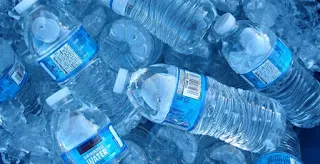7 Things You Need To Check Next Time You Buy Bottled Water: What should I look for when buying bottled water?
The remaining letters can be used to symbolize the chemicals present in the water you are drinking. Plastic bottles branded with letters like HDP, HDPE, PP, and a few others do not discharge any dangerous materials into the water. Every brand is required to indicate the bottle's contents on the packaging, and we are here to help you spot contaminated water bottles.
What should I look for when buying bottled water?
1. PET or PETE -- stands for single-use bottles. These bottles can possibly release heavy metals and chemicals that affect the hormonal balance.
2. HDP or HDPE -- plastic that practically releases no chemicals. Experts recommend choosing these bottles when buying bottled water because it is probably the healthiest water you can find on the market.
3. PVC or 3V -- releases 2 toxic chemicals that affect the hormones in your body.
4. LDPE -- this plastic can not be used in the production of bottles, but in plastic bags, even though it does not release any chemicals into the water.
5. PP -- another white-colored or semi-transparent plastic, used as a packing for syrups and yogurt cups.
6. PS -- releases some carcinogenic substances, and it is commonly used in the production of coffee cups and fast food casings.
7. PC or non-labeled plastic -- the most dangerous plastic in food production which releases BPA chemicals, and it is often used in the production of sports water bottles and food containers.
This category is a catch-all for polycarbonate and other plastics. Polycarbonate is known to contain BPA, which “has been shown to interfere with reproductive development in animals and has been linked with cardiovascular disease and diabetes in humans. Polycarbonates also contain xenoestrogen, a known endocrine disruptor. This plastic is mainly found in reusable water bottles and baby bottles.
Although BPA-free bottles are on the market, they aren’t much safer. BPS, the compound used to replace BPA can disrupt normal cell functions and contribute to metabolic disorders, birth defects, asthma, or even cancer.
“[Manufacturers] put ‘BPA-free’ on the label, which is true. The thing they neglected to tell you is that what they’ve substituted for BPA has not been tested for the same kinds of problems that BPA has been shown to cause. That’s a little bit sneaky,” says Cheryl Watson, a specialist in cancer research, cell biology, and endocrinology at The University of Texas Medical Branch in Galveston.
The Scientific American also reports that Hong-Sheng Wang, an associate professor at the University of Cincinnati, found that both BPA and BPS cause heart arrhythmia in rats. Needless to say, #7 plastic should be avoided at all costs.
That is unless they are compostable. That’s right, compostable bottles have also ended up in category #7. You can tell them apart from their toxic counterparts because they have the initials “PLA” near their recycling symbol. This compostable plastics are much safer than nearly all the products on this list but should not be reused or recycled.
The bottom line: Avoid being duped by items labeled "BPA-free." Although carrying a reusable glass bottle and filling it up during the day is a good alternative, compostable bottles are still a terrific choice.
As of today, check the bottom of the bottle twice!











.jpeg)